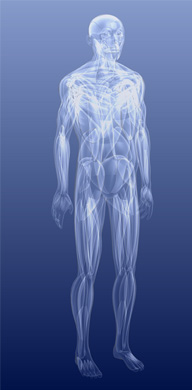The Research behind Rolfing® Structural Integration
Research Awards
 Dr. Biol.Hum. Robert Schleip of Ulm University, and Research Director of the European Rolfing Association e.V., was recently awarded the prestigious Vladamir Janda Prize for Musculo-skeletal Medicine in Leipzig. The award is presented by the German Society for Manual Medicine (Deutschen Gesellschaft für Manuelle Medizin), the Society of Manual Medicine Physicians (Ärztegesellschaft für Manuelle Medizin), as and the Physiobörse (Wittlich) every two years.
Dr. Biol.Hum. Robert Schleip of Ulm University, and Research Director of the European Rolfing Association e.V., was recently awarded the prestigious Vladamir Janda Prize for Musculo-skeletal Medicine in Leipzig. The award is presented by the German Society for Manual Medicine (Deutschen Gesellschaft für Manuelle Medizin), the Society of Manual Medicine Physicians (Ärztegesellschaft für Manuelle Medizin), as and the Physiobörse (Wittlich) every two years.
Dr. Schleip’s contribution was to prove that human fascia is regularly populated with myofibro-blasts, cells similar to those found in smooth muscle, and already well known for their role in wound healing, as well as pathologies involving chronic tissue contraction. Additionally, the fascia of the lower back has also been shown to posses a particularly high concentration of such contractile cells. While current doctrine assigns fascia, the dense white-coloured connective tissue that surrounds muscles and many other structures in the human body, a purely passive role in the transmission of force, this discovery opens the door for future fascial research to establish new directions in the understanding and treatment of back pain.
European Rolfing® Association e.V. Research Efforts
ERA is supporting scientific research into the effects, effectiveness and therapeutic mechanisms of the Rolfing process in:
- Physiology and Medicine,
- Preventive Care & Maintenance of Health,
- Psychology and Sociology,
- Anthropology and Philosophy.
For further information, contact:
- Dr. biol.hum. Robert Schleip, Research Director of the ERA: robert.schleip@uni-ulm.de
- Dr. phil. Gertrud Hartmann-Meitzner, Scientific Adviser of the ERA, Research Coordination: gertrud.meitzner@rolfing.org
The Rolfing Institute of Structural Integration
The Institute has gathered a comprehensive Bibliography of Research Articles related to Rolfing Structural Integration which can be viewed online.
Connective Tissue and Gravity
Connective tissue interrelates all internal parts of the human body and divides its functioning units. This organ, linking all structures, is called the fascial web.
It was Dr. Rolf's theory that the cause of human discomfort, both physical and emotional, lies in the relationship of our body’s connective tissue and the earth's gravitational field
There is an optimal, more natural body alignment for each of us, which she believed eases interaction between self and gravity. When this alignment is lost through external factors, it causes internal stress that can manifest in the body’s connective tissue causing real discomfort. Prevent or correct misalignments and the stress can be eliminated or at least reduced. This is a central principle underlying Rolfing.
Fascia is constantly changing and adapting to demands placed on the individual's body. It reacts to particular physical stresses by producing additional material that enhances stability and support. However, in some instances, more material than necessary is produced, the result can be reduced mobility instead of stabilization. This loss of mobility then negatively affects posture and movement patterns.
Dr. Rolf called fascia the "Organ of Form" and suggested that through deliberate, accurate and precise movement of this tissue, over-all relief and well-being can be achieved. Through the Rolfing Touch, the elasticity and sliding capacity of the tissue can be restored and the body realigned to function with more ease. By introducing the influence of gravity on well-being Dr. Rolf broke new ground. The latest scientific findings support her theory.
Scientific Literature supporting Rolfing
Since the nineteen-seventies, researchers have published numerous scientific results about Rolfing. These studies show that Rolfing can effectively change body structure, posture and movement of clients, with lasting effects. Psychological effects are often described, as well.